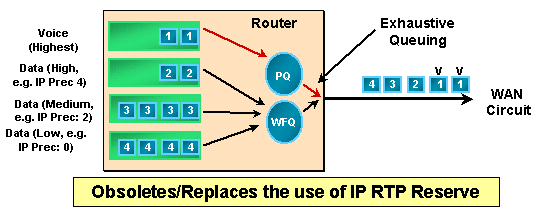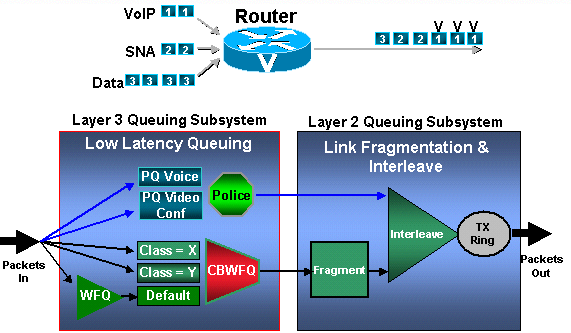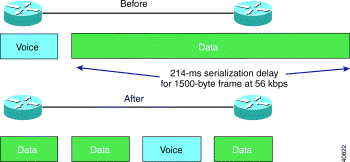使用訊框中繼的VoIP與服務品質(分段、流量調節、LLQ/IP RTP優先順序)
目錄
簡介
本檔案將說明使用服務品質(QoS)的IP語音(VoIP)訊框中繼網路範例組態。 本文包含有關已設定功能的背景技術資訊、設計原則、基本驗證和疑難排解策略。
必須注意的是,本文檔中的配置包含兩個連線到幀中繼網路的語音路由器。但是,在許多拓撲中,支援語音的路由器可以位於任何位置。通常,語音路由器使用LAN連線到連線到WAN的其他路由器。這一點非常重要,因為如果您的語音路由器沒有直接連線到幀中繼網路,則所有WAN配置命令必須在連線到WAN的路由器上配置,而不是在語音路由器上配置,如本文檔中的配置所示。
必要條件
需求
本文件沒有特定需求。
採用元件
本文中的資訊係根據以下軟體和硬體版本:
-
採用Cisco IOS®軟體版本12.2.6a(Enterprise Plus)的Cisco 3640路由器
-
採用Cisco IOS軟體版本12.2.6a(Enterprise Plus)的Cisco 2621路由器
-
訊框中繼永久虛擬電路(PVC)上的低延遲佇列(LLQ)。 這在Cisco IOS軟體版本12.1.(2)T中匯入。
-
訊框中繼IP即時傳輸通訊協定(RTP)優先順序,是在Cisco IOS軟體版本12.0(7)T中匯入。
-
訊框中繼論壇(FRF)。12分段(Cisco IOS軟體版本12.0(4)T中匯入)。
-
12.0.5T以後的Cisco IOS軟體版本對壓縮RTP(cRTP)有顯著的效能提升。
本文中的資訊是根據特定實驗室環境內的裝置所建立。文中使用到的所有裝置皆從已清除(預設)的組態來啟動。如果您的網路正在作用,請確保您已瞭解任何指令可能造成的影響。
慣例
如需文件慣例的詳細資訊,請參閱思科技術提示慣例。
訊框中繼VoIP的QoS設計准則
良好的語音品質有兩個基本要求:
要保證滿足上述要求,請使用以下准則:
語音流量的嚴格優先順序(LLQ或IP RTP優先順序)
為語音流量提供嚴格優先順序的兩種主要方法:
-
IP RTP優先順序(也稱為優先順序佇列/加權公平佇列(PQ/WFQ))
-
LLQ(也稱為PQ/類別型加權公平佇列(PQ/CBWFQ))
IP RTP優先順序
訊框中繼IP RTP優先順序會在訊框中繼PVC上為屬於使用者資料包通訊協定(UDP)目的地連線埠範圍的一組RTP封包流量建立嚴格的優先順序佇列。雖然實際使用的埠是在終端裝置或網關之間動態協商的,但所有Cisco VoIP產品都使用相同的UDP埠範圍(16384到32767)。 路由器識別VoIP流量後,就會將其放入嚴格的PQ中。當PQ為空時,其他隊列將根據標準WFQ進行處理。IP RTP優先順序不會變為活動狀態,直到介面出現擁塞。此圖說明IP RTP優先順序的運作方式:

注意:IP RTP優先順序允許在預設隊列(WFQ)上有可用頻寬時突發PQ。 但是,當介面出現擁塞時,它會嚴格控制PQ內容。
LLQ
LLQ是一種為CBWFQ提供嚴格PQ的功能。LLQ在類級別啟用CBWFQ內的單個嚴格PQ。使用LLQ時,延遲敏感資料(在PQ中)首先出列並傳送。在採用LLQ的VoIP實施中,語音流量被置於嚴格的PQ中。
對PQ進行管制以確保公平隊列不缺少頻寬。配置PQ時,您以Kbps為單位指定PQ可用的最大頻寬量。當介面擁塞時,會為PQ提供服務,直到負載達到優先順序語句中配置的Kbps值。接著,系統會捨棄多餘的流量,以避免思科舊版優先順序群組功能耗盡較低的PQ的問題。
注意:使用幀中繼的LLQ,可以根據PVC設定隊列。每個PVC都有一個PQ和一個已分配的公平隊列數。

此方法比IP RTP優先順序更複雜、更靈活。兩種方法之間的選擇需要基於實際網路中的流量模式和您的需求。
LLQ與IP RTP優先順序比較
此表總結了LLQ和IP RTP優先順序之間的主要差異,並提供了何時使用每種方法的准則。
| LLQ | IP RTP優先順序 |
|---|---|
根據以下條件匹配語音流量:
|
根據以下條件匹配語音流量:
|
指南:
|
|
適用於語音的FRTS
FRTS提供的引數可用於管理網路流量擁塞。FRTS通過到中心站點的高速連線以及到分支站點的低速連線,消除了幀中繼網路中的瓶頸。可以配置速率實施值以限制從中心站點的虛擬電路(VC)傳送資料的速率。
這些定義與FRTS有關:
-
承諾資訊速率(CIR) — 幀中繼提供商為資料傳輸保證的速率(每秒位數)。CIR值由幀中繼服務提供商設定,並由路由器上的使用者配置。
注意:埠/介面訪問速率可以高於CIR。速率是在承諾速率測量間隔(Tc)時間段內進行平均的。
-
承諾突發量(Bc) — 幀中繼網路承諾通過Tc傳輸的最大位數。Tc = Bc / CIR。
-
Excess Burst(Be) — 幀中繼交換機嘗試通過Tc傳輸超過CIR的最大未承諾位數。
-
承諾速率測量間隔(Tc) — 傳輸Bc或(Bc+ Be)位的時間間隔。Tc計算為Tc = Bc / CIR。思科路由器上未直接配置Tc值。該值在配置Bc和CIR值後計算。Tc不能超過125毫秒。
-
後向顯式擁塞通知(BECN) — 幀中繼幀報頭中的一個位,表示網路中的擁塞。當幀中繼交換機識別擁塞時,它會在發往源路由器的幀上設定BECN位,並指示路由器降低傳輸速率。
語音流量的FRTS配置與僅資料流量整形配置不同。配置FRTS語音品質時,資料流量引數會受到影響。有關這些限制的更多資訊,請參閱本檔案的分段(FRF.12)一節。
分段(FRF.12)
語音資料整合面臨的一大挑戰是,控制對時間敏感的流量(如語音)的最大單向端到端延遲。為了獲得良好的語音品質,此延遲需要小於150毫秒。此延遲的一個重要部分是介面上的序列化延遲。思科建議此值應為10毫秒,且不應超過20毫秒。序列化延遲是實際將位放在介面上的時間。
Serialization Delay = frame size (bits) / link bandwidth (bps)
例如,1500位元組的封包在56 Kbps連結上離開路由器需要214毫秒。如果傳送了1500位元組的非即時資料包,即時(語音)資料包將排隊,直到傳送大型資料包。此延遲對於語音流量來說是不可接受的。如果非即時資料包被分段為更小的幀,則它們與即時(語音)幀交織在一起。通過這種方式,語音幀和資料幀可以在低速鏈路上一起傳輸,而不會對即時語音業務造成過度延遲。

有關分段的詳細資訊,請參閱語音的幀中繼分段。
注意:如果您有專用半T1連線(768 kbps),則可能不需要分段功能。但是,您仍然需要QoS機制(本例中為IP RTP優先順序或LLQ)。 半T1或更高的速度提供足夠的頻寬,使語音資料包能夠在建議的序列化延遲範圍(10 ms,不晚於20 ms)內進入和離開隊列。 此外,您可能不需要在完整T1的情況下通過壓縮IP RTP報頭來幫助節省頻寬的cRTP。
頻寬減少
cRTP
根據RFC 2508 ![]() ,cRTP功能將IP/UDP/RTP資料包報頭從40位元組壓縮為2或4位元組。這減少了不必要的頻寬消耗。這是一種逐跳壓縮方案。因此,除非配置了被動選項,否則必須在鏈路兩端配置cRTP。
,cRTP功能將IP/UDP/RTP資料包報頭從40位元組壓縮為2或4位元組。這減少了不必要的頻寬消耗。這是一種逐跳壓縮方案。因此,除非配置了被動選項,否則必須在鏈路兩端配置cRTP。
注意:cRTP不是確保良好語音品質的必需項。此功能可降低頻寬消耗。在滿足所有其他條件且語音品質良好後配置cRTP。此過程可隔離潛在的cRTP問題,因此可節省故障排除時間。
監控路由器的CPU利用率。如果cRTP高於75%,請將其禁用。在更高的鏈路速率下,cRTP的頻寬節省可能會被額外的CPU負載所抵消。思科僅建議對低於768 Kbps的鏈路使用cRTP,除非路由器以低的CPU利用率運行。
注意:由於沒有標準,幀中繼的cRTP是在Cisco專有封裝上開發的。因此,它不適用於幀中繼的Internet工程任務組(IETF)封裝。最近,最終確定了FRF.20,以便在IETF封裝上實現RTP報頭壓縮。但是,截至本文檔上次更新(2002年5月)時,不支援FRF.20。
有關詳細資訊,請參閱壓縮即時傳輸協定。
編碼器/解碼器(編解碼器)選擇
在VoIP呼叫段上使用低位元率編解碼器。G.729(8 Kbps)是VoIP撥號對等體的預設編解碼器。
注意:雖然在使用高位元率語音編解碼器(如G.711)時雙音多頻(DTMF)通常可以精確傳輸,但低位元率編解碼器(如G.729和G.723.1)針對語音模式進行了高度最佳化,並且容易扭曲DTMF音調。這種方法可能導致訪問互動式語音應答(IVR)系統時出現問題。dtmf relay命令解決了DTMF失真問題。它在帶外傳輸DTMF音調或將其與編碼語音流分離。如果使用低位元率編解碼器(G.729、G.723),請在VoIP撥號對等體下開啟dtmf relay命令。
啟用語音活動檢測(VAD)
典型的對話可能包含35%到50%的沈默。使用VAD時,會抑制靜默資料包。對於VoIP頻寬規劃,假設VAD將頻寬減少了35%。VAD預設配置在VoIP撥號對等體下。
設定
本節提供用於設定本文件中所述功能的資訊。
注意:要查詢有關本文檔中使用的命令的其他資訊,請使用命令查詢工具(僅限註冊客戶)。
LLQ
使用以下過程配置LLQ:
-
為VoIP流量建立類對映並定義匹配條件。
以下命令說明了如何完成此任務:
maui-voip-sj(config)#class-map ? WORD class-map name match-all Logical-AND all matching statements under this classmap match-any Logical-OR all matching statements under this classmap maui-voip-sj(config)#class-map match-all voice-traffic !--- Choose a descriptive class_name. maui-voip-sj(config-cmap)#match ? access-group Access group any Any packets class-map Class map cos IEEE 802.1Q/ISL class of service/user priority values destination-address Destination address input-interface Select an input interface to match ip IP specific values mpls Multi Protocol Label Switching specific values not Negate this match result protocol Protocol qos-group Qos-group source-address Source address !--- In this example the access-group matching !--- option is used for its flexibility (it uses an access-list). maui-voip-sj(config-cmap)#match access-group ? <1-2699> Access list index name Named Access List maui-voip-sj(config-cmap)#match access-group 102 !--- Create the access-list to match the class-map access-group: maui-voip-sj(config)#access-list 102 permit udp any any range 16384 32767 !--- The safest and easiest way is to match with UDP port range 16384-32767. !--- This is the port range Cisco IOS H.323 products utilize to transmit !--- VoIP packets.這些存取清單也用於使用match access-group指令將語音流量配對:
access-list 102 permit udp any any precedence critical !--- This list filters traffic based on the IP packet TOS: Precedence field. !--- Note: Ensure that the other non-voice traffic does not use the !--- same precedence value. access-list 102 permit udp any any dscp ef !--- In order for this list to work, ensure that VoIP packets are tagged !--- with the dscp ef code before they exit on the LLQ WAN interface. !--- For more information on DSCP, refer to !--- Implementing Quality of Service Policies with DSCP. !--- Note: If endpoints are not trusted on their packet marking, !--- mark incoming traffic by applying an inbound service policy on an !--- inbound interface. This procedure is out of the scope !--- of this document. access-list 102 permit udp host 192.10.1.1 host 192.20.1.1 !--- This access-list can be used in cases where the VoIP !--- devices cannot do precedence or DSCP marking and you !--- cannot determine the VoIP UDP port range.
以下是可用來代替access-group命令的其他匹配方法:
-
使用Cisco IOS軟體版本12.1.2.T和更新版本時,會為LLQ實作IP RTP優先順序功能。此功能與檢視已配置的UDP埠的優先順序類內容相匹配。它受限於僅為PQ中的埠提供服務的限制。
class-map voice match ip rtp 16384 16383
-
這兩種方法的運行假設是:在應用出站LLQ操作之前,VoIP資料包在始發主機上標籤,或在路由器上匹配並標籤:
class-map voice match ip precedence 5
或
class-map voice match ip dscp ef
注意:在Cisco IOS軟體版本12.2.2T及更高版本中,VoIP撥號對等體可以在LLQ操作之前標籤語音承載和信令資料包。這允許使用可擴展的方法通過LLQ的DSCP代碼值來標籤和匹配VoIP資料包。有關詳細資訊,請參閱使用DSCP對QoS對VoIP信令和媒體進行分類。
Router(config-dial-peer)#ip qos dscp ?
-
-
為VoIP信令建立類對映並定義匹配條件(可選)。
使用以下命令完成此任務:
class-map voice-signaling match access-group 103 ! access-list 103 permit tcp any eq 1720 any access-list 103 permit tcp any any eq 1720
注意:VoIP呼叫可以使用H.323、會話發起協定(SIP)、媒體網關控制協定(MGCP)或精簡呼叫控制協定(SCCP)(Cisco Call Manager使用的專有協定)建立。上一個範例假設使用H.323快速連線。此清單可作為VoIP信令和控制通道所使用的埠的參考:
-
H.323/H.225 = TCP 1720
-
H.323/H.245 = TCP 11xxx(標準連線)
-
H.323/H.245 = TCP 1720(快速連線)
-
H.323/H.225 RAS = UDP 1718(到GateKeeper)
-
SCCP = TCP 2000-2002(CM核心)
-
ICCP = TCP 8001-8002(CM核心)
-
MGCP = UDP 2427、TCP 2428(CM核心)
-
SIP= UDP 5060、TCP 5060(可配置)
-
-
建立策略對映並將其與VoIP類對映關聯。
策略對映的目的是定義如何共用連結資源或將其分配給不同的對映類。使用以下命令完成此任務:
maui-voip-sj(config)#policy-map VOICE-POLICY !--- Choose a descriptive policy_map_name. maui-voip-sj(config-pmap)#class voice-traffic maui-voip-sj(config-pmap-c)#priority ? <8-2000000> Kilo Bits per second !--- Configure the voice-traffic class to the strict PQ !--- (priority command) and assign the bandwidth. maui-voip-sj(config-pmap)#class voice-signaling maui-voip-sj(config-pmap-c)#bandwidth 8 !--- Assign 8 Kbps to the voice-signaling class. maui-voip-sj(config-pmap)#class class-default maui-voip-sj(config-pmap-c)#fair-queue !--- The remaining data traffic is treated as WFQ.
注意:雖然可以將各種型別的即時流量排隊到PQ,但思科建議您僅將語音流量定向到它。即時流量(如影片)可能會引起延遲的變化(PQ是先進先出(FIFO)隊列)。 語音流量要求延遲不可變以避免抖動。
註:priority和bandwidth語句的值的總和需要小於或等於PVC的minCIR。否則,無法將service-policy命令分配給鏈路。預設情況下,minCIR是CIR的一半。若要看到錯誤訊息,請確保logging console命令對控制檯訪問啟用,並且為Telnet訪問啟用terminal monitor命令。
有關bandwidth和priority命令的詳細資訊,請參閱比較bandwidth和priority命令的QoS服務策略。
-
通過將策略對映應用於出站WAN介面來啟用LLQ。
使用以下命令啟用LLQ:
maui-voip-sj(config)#map-class frame-relay VoIPovFR maui-voip-sj(config-if)#service-policy output VOICE-POLICY !--- The service-policy is applied to the PVC !--- indirectly by configuring !--- it under the map-class associated to the PVC.
IP RTP優先順序
如果不使用LLQ,請使用以下准則:
Router(config-map-class)#frame-relay ip rtp priority starting-rtp-port port-range bandwidth
-
starting-rtp-port — 起始UDP埠號。將資料包傳送到的最低埠號。對於VoIP,請將此值設定為16384。
-
port-range - UDP目標埠的範圍。新增到starting-rtp-port的數字產生最高的UDP埠號。對於VoIP,請將此值設定為16383。
-
bandwidth — 優先順序隊列允許的最大頻寬(以kbps為單位)。根據同時呼叫數設定此號碼,新增系統支援的每個呼叫的頻寬。
示例配置:
map-class frame-relay VoIPovFR frame-relay cir 64000 frame-relay BC 600 no frame-relay adaptive-shaping frame-relay fair-queue frame-relay fragment 80 frame-relay ip rtp priority 16384 16383 45
語音流量調節
設定語音的流量調節時,請使用以下准則:
-
請勿超過PVC的CIR。
-
禁用幀中繼自適應整形。
-
將Bc值設定為低,以便Tc(整形間隔)為10毫秒(Tc = Bc/CIR)。 配置Bc值以強制使用所需的Tc值。
-
將Be值設定為0。
有關這些指南的詳細資訊,請參閱適用於VoIP和VoFR的幀中繼流量調節。
注意:部分客戶使用單獨的PVC處理資料和語音。如果您有兩個單獨的PVC,並且想要在語音PVC的CIR以下時突發資料PVC,則由於這些PVC使用相同的物理介面,語音品質仍會受到影響。在這種情況下,幀中繼提供商和路由器需要確定語音PVC的優先順序。後者可通過PVC介面優先順序佇列(PIPQ)完成,自Cisco IOS軟體版本12.1(1)T起可用。
分段(FRF.12)
為低速鏈路(小於768 kbps)啟用分段。 設定分段大小,使語音資料包不會分段,並且序列化延遲不會大於20毫秒。根據路由器之間的最低埠速度設定分段大小。例如,如果存在集線器和分支幀中繼拓撲,其中集線器的速度為T1,遠端路由器的埠速度為64 K,則需要為兩台路由器的64 K速度設定分段大小。共用相同實體介面的任何其他PVC都需要將分段設定為語音PVC使用的大小。使用此圖表可確定分段大小值。
| 路徑中的最低鏈路速度 | 建議的分段大小(用於10 ms序列化) |
|---|---|
| 56 Kbps | 70 位元組 |
| 64 Kbps | 80 位元組 |
| 128 Kbps | 160 位元組 |
| 256 Kbps | 320 位元組 |
| 512 Kbps | 640 位元組 |
| 768 Kbps | 1000 位元組 |
| 1536 Kbps | 1600 位元組 |
示例配置:
map-class frame-relay VoIPovFR !--- Some output is omitted. frame-relay fragment 80
注意:對於1536 Kbps,在技術上不需要分段。但是,需要分段來啟用雙FIFO排隊系統以確保語音品質。1600位元組的片段大小啟用雙FIFO。但是,由於1600位元組高於典型的序列介面最大傳輸單位(MTU),因此大型資料封包不會分段。
網路圖表
本檔案會使用下圖所示的網路設定:

組態
本檔案使用如下所示的組態:
-
maui-voip-sj(Cisco 3640)
-
maui-voip-austin(Cisco 3640)
| maui-voip-sj(Cisco 3640) |
|---|
version 12.2 service timestamps debug datetime msec service timestamps log datetime msec service password-encryption ! hostname maui-voip-sj ! logging buffered 10000 debugging enable secret 5 $1$MYS3$TZ6bwrhWB25b2cVpEVgBo1 ! ip subnet-zero ! !--- Definition of the voice signaling and traffic class maps. !--- "voice-traffic" class uses access-list 102 for its matching criteria. !--- "voice-signaling" class uses access-list 103 for its matching criteria. class-map match-all voice-signaling match access-group 103 class-map match-all voice-traffic match access-group 102 ! !--- The policy map defines how the link resources are assigned !--- to the different map classes. In this configuration, strict PQ !--- is assigned to the voice-traffic class !--- with a maximum bandwidth of 45 Kbps. policy-map VOICE-POLICY class voice-traffic priority 45 class voice-signaling bandwidth 8 !--- Assigns a queue for voice-signaling traffic that ensures 8 Kbps. !--- Note that this is optional and has nothing to do with good voice !--- quality. Instead, it is a way to secure signaling. class class-default fair-queue !--- The class-default class is used to classify traffic that does !--- not fall into one of the defined classes. !--- The fair-queue command associates the default class WFQ queueing. ! interface Ethernet0/0 ip address 172.22.113.3 255.255.255.0 half-duplex ! interface Serial0/0 bandwidth 128 no ip address encapsulation frame-relay no fair-queue frame-relay traffic-shaping frame-relay ip rtp header-compression !--- Turns on traffic shaping and cRTP. If traffic-shaping is not !--- enabled, then map-class does not start and FRF.12 and LLQ does !--- not work. ! interface Serial0/0.1 point-to-point bandwidth 128 ip address 192.168.10.2 255.255.255.252 frame-relay interface-dlci 300 class VOIPovFR !--- This command links the subinterface to a VoIPovFR map-class. !--- See the map-class frame-relay VoIPovFR command here: !--- Note: The word VoIPovFR is selected by the user. ! ip classless ip route 172.22.112.0 255.255.255.0 192.168.10.1 ! map-class frame-relay VOIPovFR no frame-relay adaptive-shaping !--- Disable Frame Relay BECNS. Note also that Be equals 0 by default. frame-relay cir 64000 frame-relay bc 640 !--- Tc = BC/CIR. In this case Tc is forced to its minimal !--- configurable value of 10 ms. frame-relay be 0 frame-relay mincir 64000 !--- Although adaptive shaping is disabled, make CIR equal minCIR !--- as a double safety. By default minCIR is half of CIR. service-policy output VOICE-POLICY !--- Enables LLQ on the PVC. frame-relay fragment 80 !--- Turns on FRF.12 fragmentation and sets the fragment size equal to 80 bytes. !--- This value is based on the port speed of the slowest path link. !--- This command also enables dual-FIFO. ! access-list 102 permit udp any any range 16384 32767 access-list 103 permit tcp any eq 1720 any access-list 103 permit tcp any any eq 1720 ! !--- access-list 102 matches VoIP traffic !--- based on the UDP port range. !--- Both odd and even ports are put into the PQ. !--- access-list 103 matches VoIP signaling protocol. In this !--- case, H.323 V2 is uesd with the fast start feature. ! voice-port 1/0/0 ! dial-peer voice 1 pots destination-pattern 5000 port 1/0/0 ! dial-peer voice 2 voip destination-pattern 6000 session target ipv4:192.168.10.1 dtmf-relay cisco-rtp ip precedence 5 |
| maui-voip-austin(Cisco 3640) |
|---|
version 12.2
service timestamps debug datetime msec
service timestamps log datetime msec
service password-encryption
!
hostname maui-voip-austin
!
boot system flash slot1:c3640-is-mz.122-6a.bin
logging buffered 1000000 debugging
!
ip subnet-zero
!
class-map match-all voice-signaling
match access-group 103
class-map match-all voice-traffic
match access-group 102
!
policy-map voice-policy
class voice-signaling
bandwidth 8
class voice-traffic
priority 45
class class-default
fair-queue
!
interface Ethernet0/0
ip address 172.22.112.3 255.255.255.0
no keepalive
half-duplex
!
interface Serial0/0
bandwidth 64
no ip address
encapsulation frame-relay
no ip mroute-cache
no fair-queue
frame-relay traffic-shaping
frame-relay ip rtp header-compression
!
interface Serial0/0.1 point-to-point
bandwidth 64
ip address 192.168.10.1 255.255.255.252
frame-relay interface-dlci 400
class VOIPovFR
!
ip classless
ip route 172.22.113.0 255.255.255.0 192.168.10.2
!
map-class frame-relay VOIPovFR
no frame-relay adaptive-shaping
frame-relay cir 64000
frame-relay bc 640
frame-relay be 0
frame-relay mincir 64000
service-policy output voice-policy
frame-relay fragment 80
access-list 102 permit udp any any range 16384 32767
access-list 103 permit tcp any eq 1720 any
access-list 103 permit tcp any any eq 1720
!
voice-port 1/0/0
!
dial-peer voice 1 pots
destination-pattern 6000
port 1/0/0
!
dial-peer voice 2 voip
destination-pattern 5000
session target ipv4:192.168.10.2
dtmf-relay cisco-rtp
ip precedence 5 |
驗證和疑難排解
本節提供的資訊用於確認您的組態是否正常運作。
輸出直譯器工具支援某些show命令(僅限註冊客戶)。 這麼做可以看出show指令輸出的分析。
LLQ/IP RTP Priority命令
以下show和debug命令可幫助您驗證LLQ和IP RTP優先順序配置。
-
show policy-map interface serial interface# — 此命令可用於檢視LLQ操作和PQ中的任何丟包。如需此命令各個欄位的詳細資訊,請參閱show policy-map interface輸出中的了解封包計數器。
-
show policy-map policy_map_name — 顯示有關策略對映配置的資訊。
-
show queue interface-type interface-number — 列出特定介面的公平排隊配置和統計資訊。
-
debug priority — 顯示PQ事件並顯示此隊列中是否發生刪除。如需詳細資訊,請參閱使用優先順序佇列排解輸出捨棄的疑難排解。
-
show class-map class_name — 顯示有關類對映配置的資訊。
-
show call active voice — 在DSP級別檢查丟失的資料包。
-
show frame-relay ip rtp header-compression — 顯示RTP報頭壓縮統計資訊。
分段命令
使用這些debug和show命令驗證分段配置並對其進行故障排除。
-
show frame-relay fragment — 顯示有關在Cisco路由器中發生的幀中繼分段的資訊。
-
debug frame-relay fragment — 顯示與幀中繼分段相關的事件或錯誤消息。它僅在選定介面的PVC級別啟用。
訊框中繼/介面命令
使用這些show命令檢驗幀中繼/介面配置並排除故障。
-
show traffic-shape queue interface — 顯示有關在VC資料鏈路連線識別符號(DLCI)級別排隊的元素的資訊。用於驗證使用幀中繼的IP RTP優先順序的工作原理。當鏈路擁塞時,語音流的權重為零。這表示語音流使用PQ。請參閱此處的示例輸出。
-
show traffic-shape — 顯示諸如Tc、Bc、Be和CIR配置值等資訊。請參閱輸出示例。
-
show frame-relay pvc dlci-# — 顯示諸如流量整形引數、分段值和丟棄的資料包等資訊。請參閱輸出示例。另請參閱幀中繼故障排除。
已知的問題
根據每個VC LLQ識別了一個錯誤,其中嚴格管制了PQ,即使介面上沒有擁塞。該錯誤已被修復,現在只有在VC上發生擁塞時才會丟棄非一致性語音資料包。這使每個VC LLQ的行為與使用LLQ的其他介面相同。此行為隨Cisco IOS軟體版本12.2(3)及更高版本而更改。
show和debug命令輸出示例
以下是用於驗證和疑難排解的show和debug命令輸出範例。
!--- To capture sections of this output, the LLQ PQ bandwidth !--- is lowered and large data traffic is placed !--- on the link to force packets drops. !--- Priority queue bandwidth is lowered to 10 Kbps to force drops from the PQ. !--- Note: To reset counters, use the clear counters command.
maui-voip-sj#show policy-map inter ser 0/0.1
Serial0/0.1: DLCI 300 -
Service-policy output: VOICE-POLICY
Class-map: voice-traffic (match-all)
26831 packets, 1737712 bytes
5 minute offered rate 3000 bps, drop rate 2000 bps
Match: access-group 102
Weighted Fair Queueing
Strict Priority
Output Queue: Conversation 24
Bandwidth 10 (kbps) Burst 250 (Bytes)
(pkts matched/bytes matched) 26311/1704020
(total drops/bytes drops) 439/28964
Class-map: voice-signaling (match-all)
80 packets, 6239 bytes
5 minute offered rate 0 bps, drop rate 0 bps
Match: access-group 103
Weighted Fair Queueing
Output Queue: Conversation 25
Bandwidth 8 (kbps) Max Threshold 64 (packets)
(pkts matched/bytes matched) 62/4897
(depth/total drops/no-buffer drops) 0/0/0
Class-map: class-default (match-any)
14633 packets, 6174492 bytes
5 minute offered rate 10000 bps, drop rate 0 bps
Match: any
Weighted Fair Queueing
Flow Based Fair Queueing
Maximum Number of Hashed Queues 16
(total queued/total drops/no-buffer drops) 0/0/0
!--- These commands are useful to verify the LLQ configuration.
maui-voip-austin#show policy-map voice-policy
Policy Map voice-policy
Class voice-signaling
Weighted Fair Queueing
Bandwidth 8 (kbps) Max Threshold 64 (packets)
Class voice-traffic
Weighted Fair Queueing
Strict Priority
Bandwidth 45 (kbps) Burst 1125 (Bytes)
Class class-default
Weighted Fair Queueing
Flow based Fair Queueing Max Threshold 64 (packets)
maui-voip-austin#show class-map
Class Map match-all voice-signaling (id 2)
Match access-group 103
Class Map match-any class-default (id 0)
Match any
Class Map match-all voice-traffic (id 3)
Match access-group 102
!--- Frame Relay verification command output.
maui-voip-sj#show frame-relay fragment
interface dlci frag-type frag-size in-frag out-frag dropped-frag
Serial0/0.1 300 end-to-end 80 4 4 0
maui-voip-sj#show frame-relay pvc 300
PVC Statistics for interface Serial0/0 (Frame Relay DTE)
DLCI = 300, DLCI USAGE = LOCAL, PVC STATUS = ACTIVE, INTERFACE = Serial0/0.1
input pkts 7 output pkts 7 in bytes 926
out bytes 918 dropped pkts 0 in FECN pkts 0
in BECN pkts 0 out FECN pkts 0 out BECN pkts 0
in DE pkts 0 out DE pkts 0
out bcast pkts 2 out bcast bytes 598
pvc create time 1w2d, last time pvc status changed 1w2d
service policy VOICE-POLICY
Service-policy output: VOICE-POLICY
Class-map: voice-traffic (match-all)
0 packets, 0 bytes
5 minute offered rate 0 bps, drop rate 0 bps
Match: access-group 102
Weighted Fair Queueing
Strict Priority
Output Queue: Conversation 24
Bandwidth 45 (kbps) Burst 250 (Bytes)
(pkts matched/bytes matched) 0/0
(total drops/bytes drops) 0/0
Class-map: voice-signaling (match-all)
0 packets, 0 bytes
5 minute offered rate 0 bps, drop rate 0 bps
Match: access-group 103
Weighted Fair Queueing
Output Queue: Conversation 25
Bandwidth 8 (kbps) Max Threshold 64 (packets)
(pkts matched/bytes matched) 0/0
(depth/total drops/no-buffer drops) 0/0/0
Class-map: class-default (match-any)
7 packets, 918 bytes
5 minute offered rate 0 bps, drop rate 0 bps
Match: any
Weighted Fair Queueing
Flow Based Fair Queueing
Maximum Number of Hashed Queues 16
(total queued/total drops/no-buffer drops) 0/0/0
Output queue size 0/max total 600/drops 0
fragment type end-to-end fragment size 80
cir 64000 bc 640 be 0 limit 80 interval 10
mincir 64000 byte increment 80 BECN response no
frags 13 bytes 962 frags delayed 8 bytes delayed 642
shaping inactive
traffic shaping drops 0
!--- In this Frame Relay verification command !--- output, the PQ bandwidth is lowered and heavy traffic !--- is placed on the interface to force drops.
maui-voip-sj#show frame-relay pvc 300
PVC Statistics for interface Serial0/0 (Frame Relay DTE)
DLCI = 300, DLCI USAGE = LOCAL, PVC STATUS = ACTIVE, INTERFACE = Serial0/0.1
input pkts 483 output pkts 445 in bytes 122731
out bytes 136833 dropped pkts 0 in FECN pkts 0
in BECN pkts 0 out FECN pkts 0 out BECN pkts 0
in DE pkts 0 out DE pkts 0
out bcast pkts 4 out bcast bytes 1196
pvc create time 1w2d, last time pvc status changed 1w2d
service policy VOICE-POLICY
Service-policy output: VOICE-POLICY
Class-map: voice-traffic (match-all)
352 packets, 22900 bytes
5 minute offered rate 2000 bps, drop rate 2000 bps
Match: access-group 102
Weighted Fair Queueing
Strict Priority
Output Queue: Conversation 24
Bandwidth 10 (kbps) Burst 250 (Bytes)
(pkts matched/bytes matched) 352/22900
(total drops/bytes drops) 169/11188
Class-map: voice-signaling (match-all)
7 packets, 789 bytes
5 minute offered rate 0 bps, drop rate 0 bps
Match: access-group 103
Weighted Fair Queueing
Output Queue: Conversation 25
Bandwidth 8 (kbps) Max Threshold 64 (packets)
(pkts matched/bytes matched) 7/789
(depth/total drops/no-buffer drops) 0/0/0
Class-map: class-default (match-any)
79 packets, 102996 bytes
5 minute offered rate 4000 bps, drop rate 0 bps
Match: any
Weighted Fair Queueing
Flow Based Fair Queueing
Maximum Number of Hashed Queues 16
(total queued/total drops/no-buffer drops) 5/0/0
Output queue size 5/max total 600/drops 169
fragment type end-to-end fragment size 80
cir 64000 bc 640 be 0 limit 80 interval 10
mincir 64000 byte increment 80 BECN response no
frags 2158 bytes 178145 frags delayed 1968 bytes delayed 166021
shaping active
traffic shaping drops 169
!--- Notice that the Tc interval equals 10 ms, !--- CIR equals 64000 BPS, and BC equals 640.
maui-voip-sj#show traffic-shape
Interface Se0/0.1
Access Target Byte Sustain Excess Interval Increment Adapt
VC List Rate Limit bits/int bits/int (ms) (bytes) Active
300 64000 80 640 0 10 80 -
!--- This output is captured on an isolated lab enviroment where !--- the routers are configured with IP RTP Priority instead of LLQ.
maui-voip-austin#show frame-relay PVC 100
PVC Statistics for interface Serial0/1 (Frame Relay DTE)
DLCI = 100, DLCI USAGE = LOCAL, PVC STATUS = ACTIVE, INTERFACE = Serial0/1.1
input pkts 336 output pkts 474 in bytes 61713
out bytes 78960 dropped pkts 0 in FECN pkts 0
in BECN pkts 0 out FECN pkts 0 out BECN pkts 0
in DE pkts 0 out DE pkts 0
out bcast pkts 0 out bcast bytes 0
PVC create time 1w0d, last time PVC status changed 1w0d
Current fair queue configuration:
Discard Dynamic Reserved
threshold queue count queue count
64 16 2
Output queue size 0/max total 600/drops 0
fragment type end-to-end fragment size 80
cir 64000 BC 640 be 0 limit 125 interval 10
mincir 32000 byte increment 125 BECN response no
frags 1091 bytes 82880 frags delayed 671 bytes delayed 56000
shaping inactive
traffic shaping drops 0
ip rtp priority parameters 16384 32767 45000
!--- This command displays information of the VoIP dial-peers.
maui-voip-austin#show dial-peer voice 2
VoiceOverIpPeer2
information type = voice,
tag = 2, destination-pattern = `5000',
answer-address = `', preference=0,
group = 2, Admin state is up, Operation state is up,
incoming called-number = `', connections/maximum = 0/unlimited,
application associated:
type = voip, session-target = `ipv4:192.168.10.2',
technology prefix:
ip precedence = 5, UDP checksum = disabled,
session-protocol = cisco, req-qos = best-effort,
acc-qos = best-effort,
dtmf-relay = cisco-rtp,
fax-rate = voice, payload size = 20 bytes
codec = g729r8, payload size = 20 bytes,
Expect factor = 10, Icpif = 30,signaling-type = cas,
VAD = enabled, Poor QOV Trap = disabled,
Connect Time = 165830, Charged Units = 0,
Successful Calls = 30, Failed Calls = 0,
Accepted Calls = 30, Refused Calls = 0,
Last Disconnect Cause is "10",
Last Disconnect Text is "normal call clearing.",
Last Setup Time = 69134010.
 意見
意見